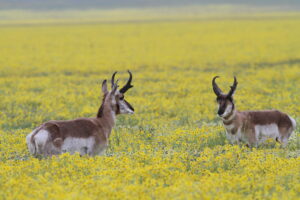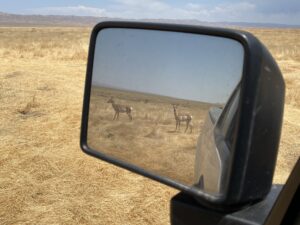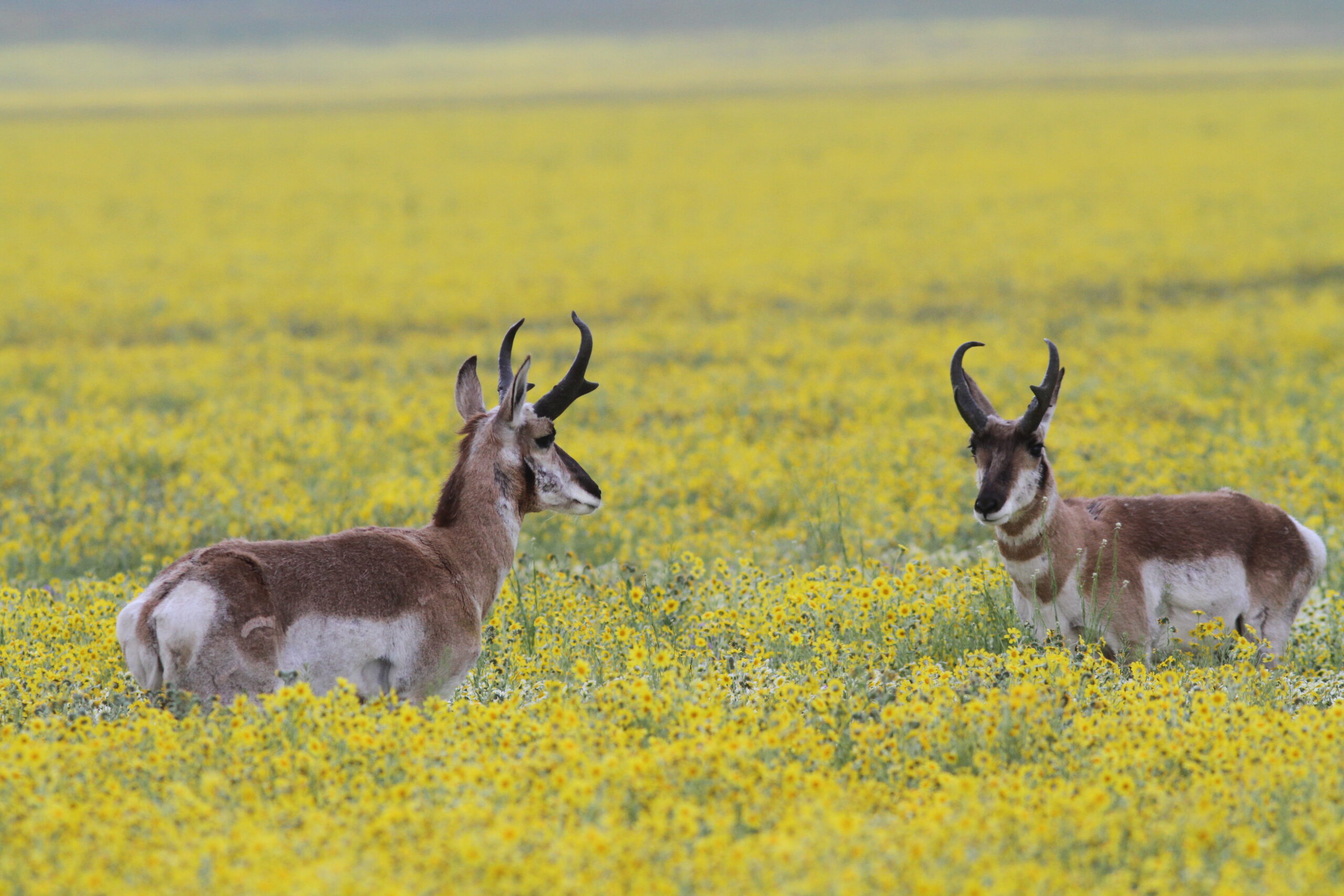FEATURE | Story & Photos by Chuck Graham
Making Their Ojai Home

Carrizo Plain pronghorn antelope
They crept out of the morning shadows of the Carrizo Plain National Monument, leaving the sanctity of a narrow ravine in the rolling foothills of the Caliente Mountains. Lured to a reliable water source, an old cattle trough left over from the grassland’s ranching era, six pronghorn antelope tiptoed forward for a sunrise drink.
Camped nearby, I slowly peeked my head out of my tent. I could hear their hoofs crunching across low-growing tan grasses that were begging for moisture. My tent was cloaked with a green rainfly. It was ideal for melding into the landscape, watching and photographing
North America’s fastest land mammal.
Sauntering in a single file, the thirsty herbivores gradually approached the cattle trough brimming with frigid water. It was late spring, but a winter chill still hovered over the Carrizo Plain with a few sheets of ice floating on the surface of the trough. I was close enough to clearly see their big black eyelashes batting as they enjoyed their morning watering hole. I barely moved, not wanting to disturb what I believed to be their daily ritual.
After they drank their fill, they browsed for several minutes before wandering southward. Eventually, they were swallowed up into the austere, semi-arid grassland biome, one of the last, best bastions for pronghorn antelope in California
Open Space
Believe it or not, it’s been estimated in the 1800s that pronghorn antelope populations in California’s San Joaquin Valley once outnumbered the great herds of buffalo on the Great Plains.
Unfortunately, like many other iconic species such as grizzly bears and wolves, pronghorn antelope were hunted out of the San Joaquin Valley by the 1920s. Over the decades, their habitat has been absorbed by agriculture and urban sprawl, with only a few pockets of habitat remaining and little or no corridors for a land mammal that needs open space to roam, but also to display that ability to reach speeds up to 55 mph, sustaining that pace longer than a cheetah.
Following the ranching era, pronghorn were reintroduced to the Carrizo Plain in 1998, before it was deemed a National Monument in January 2001. About 100 pronghorn antelope were released. Despite decent habitat on the grasslands, wildlife corridors are few, and recruitment is low. Solar and marijuana farms surround the northern fringe of the Carrizo Plain, limiting pronghorn movements into the National Monument, those grasslands offering the best viable habitat in California’s Central Valley.
“There aren’t many pronghorn,” said Brandon Swanson, an environmental scientist for the California Department of Fish and Wildlife (CDFW). “There are fewer fawns. Habitat is good, but water resources have gone derelict.”
The few fawns born on the Carrizo Plain are susceptible to predation, mainly marauding coyotes. Aerial surveys performed by CDFW are producing less and less pronghorn every year.
“Pronghorn are on a downward trend,” continued Swanson, who does research in ecology, wildlife biology, and environmental science. “Captive breeding is super intensive, but a possibility if we want to keep pronghorn on the Carrizo Plain.”
In the meantime, there are other solutions on the table. One of those is enhancing reliable water sources across the grasslands.
“Revitalizing old grazing water sources,” he said. “It’s a big undertaking, but pronghorn stick real close to water sources in the summer. There’s more dispersal in the winter.”
Another solution is drilling for more water sources and adding more appropriate animal water troughs. This would not only benefit pronghorn herds, but all wildlife throughout the National Monument. There’s also talk of increasing cover for pronghorn, especially for fawns. They are vulnerable as soon as they are born, wobbly on unsure, unstable legs.
“We want to create more plantings to provide cover for fawns,” said Swanson. “Saltbush planting structure will provide more habitat for them.”
Effortless
They accelerated with utter aplomb. A steady trot increased into a full-on sprint. A small herd of pronghorn hoofed across the grasslands for what appeared to be just the hell of it. They were not being pursued by a pack of coyotes. They simply just wanted to run.
I was sitting in my truck enjoying the sunset sinking west beyond the Carrizo Plain. I spotted the pronghorn in my rearview mirror. The band was trotting to my left, but once they were parallel with my truck, they picked up the pace, and tufts of dry grass kicked up in their wake, hurtling behind them.
Once they passed the vantage point of my truck, they turned in front of me, now circling between me and sunset. They were sprinting into a 360-degree arc, as I was thoroughly enthralled with their breakneck speed around my truck perpetually encrusted in alkali loam.
I was now gazing at them again in my rearview mirror, nostrils flared, and a plume of dust wafting in their wake. A pair of opportunistic ravens took advantage of the insects, mostly crickets churned up by the pronghorn, nothing wasting away out on the grasslands.
Wading Through
The sweeping hillside daisies were just one of many California wildflowers splashed across the Carrizo Plain during the Super Bloom of 2017. What made this specific stretch of the grasslands so special was that there were five pronghorn antelope browsing and frolicking in those vibrant, yellow blooms.
The hillside daisies swept westward from Soda Lake Road almost to Painted Rock. The pronghorn grazed closer to that sandstone cathedral than Soda Lake Road, so I wasn’t too confident that the small band of pronghorn would turn and walk toward where I stood hopelessly waiting with my camera on the road honeycombed with potholes.
It was dawn on the Carrizo Plain, and as I drove off Simmler Road and onto Soda Lake Road, the grasslands were quiet. I was consumed by the stunning yellow native flora to the southwest, and as I always do on the Carrizo Plain, I drove slowly. When I saw the pronghorn in the hillside daisies, I pulled off the road and sat silently, watching them enjoy the fleeting wildflower display. Patience settled in, and so I waited.

Rear view of pronghorns.
I’ll never know what it was that engaged the pronghorn to do 180-degree turn, but I sure was grateful when they did. As I waited by my truck, the pronghorn walked straight toward me. As they did, the younger pronghorn sort of pranced, high-stepping through the 4-foot-tall daisies.
There were also two large bulls in the band of five pronghorn. One of them became playful, dipping its antlers into the throng of tall, spindly stalks of hillside daisies, the blooms flung skyward by the animated pronghorn buck. Before I knew it, a couple of them filled my entire viewfinder.
When it comes to wildlife viewing, there’s no set agenda. It’s their schedule. So, after affording me some time to photograph their natural moment in the wildflowers, the pronghorn veered northwest. Before I knew it, I was watching them through my binoculars again. They were getting smaller, in what was maybe a fleeting, once-in-a-decade phenomenon, one natural wonder consumed by the other.


Leave A Comment